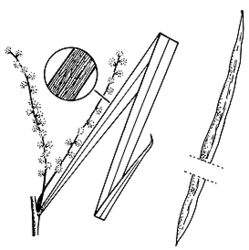Common name: North Brother wattle
Acacia courtii Tindale & Hersc. APNI* Synonyms: Racosperma courtii (Tindale & Hersc.) Pedley APNI*

Description: Tree or sometimes shrub 5–20 m high, with pendulous branches and foliage; bark smooth and grey, later finely fissured or furrowed and blackish; branchlets angled or flattened towards apices, glabrous.
Phyllodes very narrowly elliptic to linear, straight or slightly curved, mostly 10–18 cm long and 4–8 mm wide, glabrous, 1 or sometimes 3 longitudinal veins more prominent, minor veins longitudinally anastomosing forming a fine reticulum, apex acute with a mucro; 1 minute gland to 4 mm above pulvinus and 1 inconspicuous gland adjacent to the mucro; pulvinus 1–2 mm long.
Inflorescences 2 or rarely 1 in axil of phyllodes; peduncles 3–5 mm long, sparsely appressed-hairy or glabrous; heads cylindrical, 3–7 cm long, pale yellow or cream-coloured; flowers scattered on rachis.
Pods straight or slightly to strongly curved, raised over seeds or subterete (probably ± terete when fresh), barely or slightly constricted between seeds, 7.5–18 cm long, 3–4 mm wide, firmly papery to leathery, longitudinally wrinkled-ridged when dry, glabrous or with minute appressed hairs mainly at the base and apex; seeds longitudinal; funicle filiform, folded 4–8 times; aril small.
Flowering: November–January.
Distribution and occurrence: on Middle Brother and North Brother Mtns (southwest of Port Macquarie); rare. Grows in dry sclerophyll forest, in shallow soils.
NSW subdivisions: NC
Threatened species: NSW BCA: Vulnerable; Commonwealth EPBC: Vulnerable
Closely related to Acacia orites. It is named after Arthur Bertram Court, former Assistant Director of the Australian National Botanic Gardens, Canberra.
Text by P.G. Kodela (August 2005)
Taxon concept: P.G. Kodela & G.J. Harden, Flora of NSW Vol. 2 (2002)
APNI* Provides a link to the Australian Plant Name Index (hosted by the Australian National Botanic Gardens) for comprehensive bibliographic data
***The AVH map option provides a detailed interactive Australia wide distribution map drawn from collections held by all major Australian herbaria participating in the Australian Virtual Herbarium project.
|


